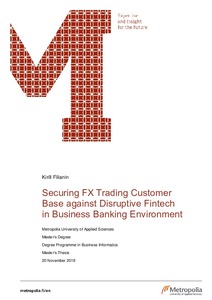Securing FX Trading Customer Base against Disruptive Fintech in Business Banking Environment
Filianin, Kirill (2019)
Filianin, Kirill
2019
All rights reserved. This publication is copyrighted. You may download, display and print it for Your own personal use. Commercial use is prohibited.
Julkaisun pysyvä osoite on
https://urn.fi/URN:NBN:fi:amk-2019120424497
https://urn.fi/URN:NBN:fi:amk-2019120424497
Tiivistelmä
In recent years, foreign exchange and cross-currency payments domain has been intensively disrupted by fintech. The study is relevant since, according to the Accenture digital report, nearly one-third of Nordic banking revenues are at risk due to fintech. This study is aimed to establish a data-driven strategy for the online trading platform to secure its existing corporate customer base within the current more competitive landscape enabled by new European regulations of the financial markets.
In this study, the action research was selected as the research methodology due to applied nature of the issue addressed and its direct applicability to the business organization. The thesis project leverages the internal data structures of the case company to conduct behavioural analysis of the corporate customer base. Current state analysis of the case company highlighted the negative year-on-year erosion (attrition) rate of the active customer base at the online trading platform. This insight should be a clear call to action to the case company top management.
The thesis project proposes the comprehensive data-driven strategy for the online trading platform of the case company which includes continuous monitoring of the health of the business banking segment, curation of the new sales funnel, and the new customer segmentation model to tailor current products and distribution channels across the customer base. The purpose of the so-called “4-Boxes” model is to be able to provide a data-driven segmentation of customer / currency pairs in order to efficiently upsell FX products and offer superior service on an individual basis by providing optimal combination of distribution channel and product. The proposed segmentation model was validated through the pilot sales campaign.
Innovative data-driven “4-Boxes” approach has been developed in response to the Second Payment Service Directive, Open Banking and flexible API platforms. Those customers from Box 1 are assessed to have the highest potential towards disruption due to usage of only basic payment services; their erosion rate is higher than in other boxes. “4-Boxes” model relies on (behavioural) data analytics to leverage the complex product offering and bring the existing business banking customer base closer to the case company, i.e. enhance customer “stickiness” and make it harder to disrupt.
In this study, the action research was selected as the research methodology due to applied nature of the issue addressed and its direct applicability to the business organization. The thesis project leverages the internal data structures of the case company to conduct behavioural analysis of the corporate customer base. Current state analysis of the case company highlighted the negative year-on-year erosion (attrition) rate of the active customer base at the online trading platform. This insight should be a clear call to action to the case company top management.
The thesis project proposes the comprehensive data-driven strategy for the online trading platform of the case company which includes continuous monitoring of the health of the business banking segment, curation of the new sales funnel, and the new customer segmentation model to tailor current products and distribution channels across the customer base. The purpose of the so-called “4-Boxes” model is to be able to provide a data-driven segmentation of customer / currency pairs in order to efficiently upsell FX products and offer superior service on an individual basis by providing optimal combination of distribution channel and product. The proposed segmentation model was validated through the pilot sales campaign.
Innovative data-driven “4-Boxes” approach has been developed in response to the Second Payment Service Directive, Open Banking and flexible API platforms. Those customers from Box 1 are assessed to have the highest potential towards disruption due to usage of only basic payment services; their erosion rate is higher than in other boxes. “4-Boxes” model relies on (behavioural) data analytics to leverage the complex product offering and bring the existing business banking customer base closer to the case company, i.e. enhance customer “stickiness” and make it harder to disrupt.
